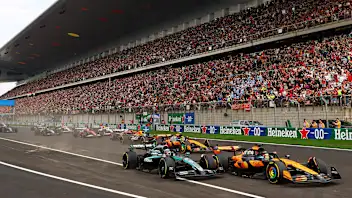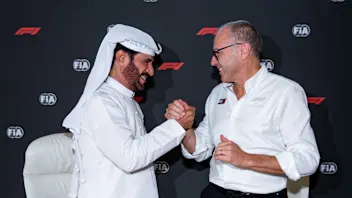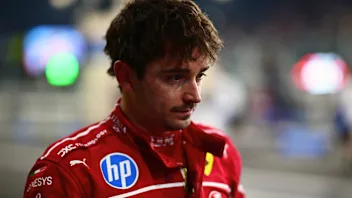For the 2014 season, Formula One racing undertook the most comprehensive regulation changes seen in the last three decades, with a move to more fuel efficient, hybrid turbocharged power units.
With 11 of the year's 19 Grands Prix complete, F1 technical expert Gary Anderson looks back on how these changes have played out so far - and looks ahead to what we can expect in the remaining races...
Chassis and aerodynamics
Here the regulation changes were aimed primarily at losing some of the downforce that the teams' engineers seem to find from nowhere year on year. This is important as it keeps a cap on performance and, more importantly, safety.
The most visible area of change resulting from this has been the nose, where the front-impact area at the nose's leading edge was lowered to reduce the risk of cars being lifted upwards when they make contact with a rotating wheel.
We have seen four different styles of nose: Mercedes and Ferrari with their low and wide solution; Red Bull and Marussia with their very neat designs featuring an impact pod hanging down underneath; Lotus with their twin tusks; and the most popular ‘anteater' design which the other teams incorporated (even Caterham's strange-looking nose is a version of this).
The detailing of this area is all about getting as much airflow as possible between the two front wheels. Achieving this means that the front wing will work better and the airflow to the underfloor will be improved, both increasing overall downforce.
Of all the different concepts I believe that the Mercedes and Red Bull versions are best overall, with the detailing of the Williams anteater solution a very close second. On any of these concepts it's all about the fine detail.
The front wing itself has been reduced in overall width. This means that the detail of the front wing endplates is a little different, but the concept remains very similar and the development direction seen over the last five years continues.
At the rear of the car the lower beam wing has been outlawed. This component produced a reasonable amount of downforce, and also helped the consistency of the downforce generated by the underfloor, especially under braking. This lost downforce has been the most difficult to replace and, together with new underfloors and diffusers, has been the area of the most chassis development.
With the chassis regulations as restricted as they are, we have not seen any major developments in the first half of the season. Instead it has all been about detail and optimisation - and I think this trend will be similar in the second half of the year.
Power unit and ERS packaging
Without doubt the biggest impact on 2014 performance - and the most difficult thing for the teams to implement - has been the introduction of the new power unit.
This consists of a 1.6 litre V6 single turbo-charged internal combustion engine (ICE), with an intercooler to reduce the intake temperature, revving to a maximum of 15,000 rpm and fuel limited to a maximum flow rate of 100kg per hour, with maximum fuel consumption of 100kg per race. Connected to that is an electrical energy recovery system (ERS).
The ERS consists of an electrical motor or MGU-K (motor generator unit-kinetic) mounted on the engine that can recharge the battery pack during braking and also increase the power of the engine under acceleration. Along with this is another electrical motor or MGU-H (motor generator unit-heat) mounted on the turbo. This can be used to charge up the battery pack, speed up the turbo to reduce turbo lag, slow the turbo down to reduce over boosting, or simply generate electrical power and send it directly to the ICE.
The battery pack and its control unit are mounted underneath the fuel tank in the middle of the car, and because of the amount of energy going into and out of this pack it needs to be fluid cooled.
Based on the season's performance so far, Mercedes appear to have a better handle on this package than Ferrari or Renault. It is not one thing that makes their unit work more efficiently: it is a very complicated package and it is about understanding the unit as a whole and optimising every detail.
For example, Mercedes have separated the hot and cold sides of the turbo and mounted their MGU-H between them. This has a benefit in packaging, heat management and also in how you can use the electrical energy. Ferrari, meanwhile, have a very neat intercooler concept that mounts in the V of the engine.
I would imagine that all of these different concepts will merge for 2015, creating one similar package that will equalise the potential performance from the different power units. However, it will still be down to how and when each team and engine supplier use the available energy.
The removal of FRIC
Just before the German Grand Prix the FIA questioned whether what was known as FRIC (front and rear interconnected) suspension had possibly gone too far and was now controlling the aerodynamic platform of the car. With the system's legality in question, the teams had to come up with normal suspension settings to control the cars.
FRIC enabled the cars to run softer suspension settings and also allowed them to run with lower ride heights, which ultimately meant they produced more downforce. Now the cars are running stiffer springs on the suspension, which means they are not as compliant over the kerbs and the locking of wheels under braking is more pronounced.
As most teams had some version of this FRIC suspension, the relative difference in performance between them when it was removed was negligible. These teams are made up of very intelligent people: give them time to scratch their heads and they will find a solution.
The reckoning
Though it would be wrong for me to pass judgement on which team is doing the best job, the numbers speak for themselves. In the table below, I have averaged the best laps completed by each driver over the 11 Grand Prix weekends to date and expressed that as a percentage of the overall fastest laps - in other words, if a driver had been quickest every weekend he would be on a perfect 100 percent. From this it is fairly easy to see which teams and drivers need to pull their fingers out. Mercedes came out on top, with Nico Rosberg fastest at seven of the 11 weekends.
1. Mercedes (Rosberg) - 100.102
2. Mercedes (Hamilton) - 100.495
3. Red Bull (Ricciardo) - 100.958
4. Ferrari (Alonso) - 101.145
5. Red Bull (Vettel) - 101.196
6. Williams (Bottas) - 101.285
7. Williams (Massa) - 101.440
8. Ferrari (Raikkonen) - 101.728
9. McLaren (Button) - 101.783
10. McLaren (Magnussen) - 101.812
11. Force India (Hulkenberg) - 102.040
12. Toro Rosso (Vergne) - 102.122
13. Toro Rosso (Kyvat) - 102.251
14. Force India (Perez) - 102.275
15. Lotus (Grosjean) - 102.847
16. Sauber (Sutil) - 103.130
17. Sauber (Gutierrez) - 103.181
18. Lotus (Maldonado) - 103.524
19. Marussia (Bianchi) - 104.448
20. Marussia (Chilton) - 105.103
21. Caterham (Kobayashi) - 105.353
22. Caterham (Ericsson) - 106.038
Still to come in 2014
The second half of the season is very tough, with the majority of races being long-distance flyaway rounds. Most teams will focus on power unit optimisation, as this is all about ICE and ERS integration. However, some teams and drivers are going to start getting penalties for using too many ICE components and this could have a major effect at the later races.
The last major developments we will see will be for the upcoming Belgian Grand Prix, as these components will have been in manufacture well before the summer break. After that it will be a split as far as chassis development is concerned. Teams who are fighting for a championship position and who still have a mathematical chance of improving their position will keep developing their cars. By contrast, teams who are not performing as they should will start to focus on 2015. We will see a few aerodynamic developments on their cars, but most of them will be circuit specific.
Looking ahead
2015 is now just around the corner and if you ask any team how competitive they are going to be they will all say they are going to win the world championship. But that is what you have got to believe - no team knowingly builds a poor car: it is the areas of the car that they don't quite understand that lets them down. What you have to do is minimise these risk areas, and if it isn't broken don't fix it.
McLaren with their new Honda relationship should be very strong. Honda have been able to sit back and see how the other power units have performed this year and this will have allowed them to put together a jigsaw of the best bits. McLaren too will have learned a lot this year and next season will want to show they are the McLaren we expect to see racing at the front.
In summation
It's been a fantastic season so far and I am really looking forward to the second half. We have had very competitive racing all the way through the field, with the extra spice of a little bit of intra-team controversy which always adds to the on-track battles. Long may it continue and with double points for the last race it could all be won or lost right there in Abu Dhabi.
Next Up
Related Articles
 Tickets on sale for 2026 Chinese Grand Prix
Tickets on sale for 2026 Chinese Grand Prix F1, the FIA and 11 teams sign 2026 Concorde Agreement
F1, the FIA and 11 teams sign 2026 Concorde Agreement ‘I have achieved my dream, that little boy's dream’ – Norris
‘I have achieved my dream, that little boy's dream’ – Norris/Untitled-10.webp) Bottas embarks on first day as a Cadillac driver
Bottas embarks on first day as a Cadillac driver Norris collects World Championship trophy at FIA Awards
Norris collects World Championship trophy at FIA Awards Leclerc hoping Ferrari will ‘get back on top’ in 2026
Leclerc hoping Ferrari will ‘get back on top’ in 2026